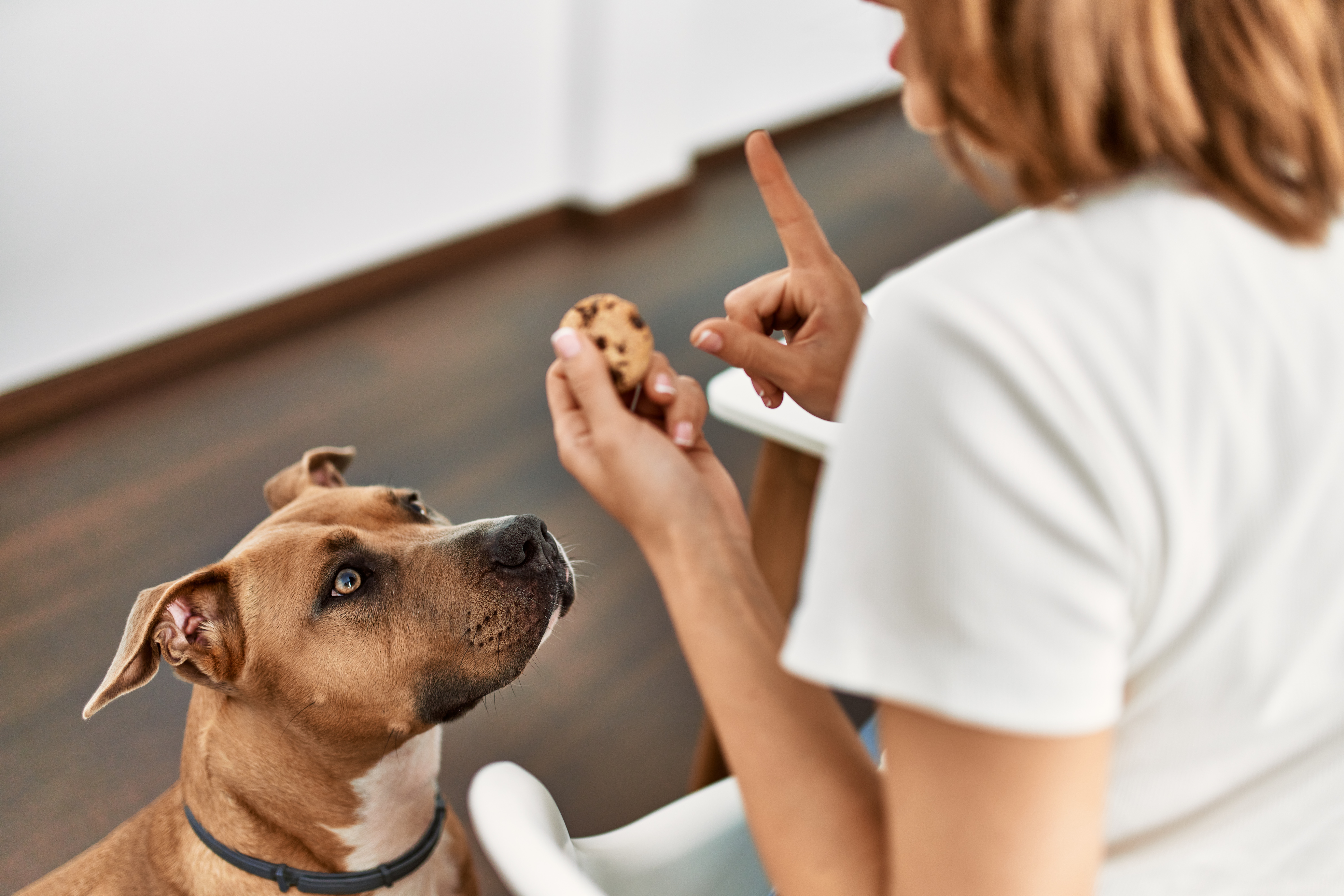Key Takeaways
- Household items can be poisonous and fatal to dogs
- Chocolate, soap, and lilies are common examples
- Recognizing poisoning symptoms can help you save your dog’s life

Many common household items pose serious health risks to dogs. These substances can cause organ failure, neurological damage, and even death. Pet owners are encouraged to create a dog-safe environment, which means capping coffee mugs, replacing lilies with fake plants, and other important precautions.
Knowing what poisoning looks like could save your dog’s life. Let’s go over the common items at home that are toxic to dogs, how to identify symptoms of poisoning, and pet safety essentials.

Common Household Substances That Are Dangerous for Dogs
Foods and Beverages
-
Chocolate: The most dangerous food for dogs. Chocolate contains caffeine and theobromine, which causes toxicosis, leading to seizures and death.
-
Coffee: Dogs should not ingest anything with caffeine, such as tea and coffee.
-
Grapes and Raisins: These cause acute kidney failure in dogs. Never give your dog anything containing grapes.
-
Xylitol (Artificial Sweetener): Extremely toxic to dogs, xylitol can cause hypoglycemia, seizures, acute liver failure, and even death. Xylitol can be found in human toothpaste, candies, and baked goods. Table sugar and other modern sweeteners should also be avoided.
-
Onions and Garlic: Dogs should never eat vegetables like onions and garlic. These contain n-propyl disulfide, a compound highly toxic to dogs. Onion poisoning causes oxidative damage to red blood cells, which could lead to death.
-
Raw Meat: Despite being carnivorous, dogs are susceptible to salmonella, E. coli, and other bacteria found in raw meat. Raw chicken is generally not good for dogs.
-
Yeast: Raw dough can cause bloat in dogs. Bloat is a life-threatening medical emergency. Avoid giving your dog bread, pizza, and other foods containing yeast.
Household Plants
Despite seeming harmless, many household plants are toxic to dogs. If a dog chews on these greens, they can be seriously hurt. It is a good idea to assume most household plants are toxic to dogs and research which ones are safe if you wish to keep houseplants around the home.
- Lilies
- Sago palm
- Aloe vera
- Azalea
- Snake plants
- Ivy
- Pothos
- Philodendron
Medications and Chemicals
Human medications: Assume that all human medications are harmful or even deadly to dogs. This includes painkillers like acetaminophen in Tylenol.
Rodenticides and Insecticides: Anything that kills pests can also hurt your dog. Even if the bait used in traps might not be toxic, a dog can still swallow the traps and choke. Don’t leave your dog alone near insecticides.
Household Cleaners and Chemicals: Household cleaning products are all toxic to dogs. This includes air fresheners, dish soap, window cleaners, and all-purpose cleaners.
Antifreeze: Even a little bit of antifreeze can kill a dog. Dealing with antifreeze poisoning also requires special treatment. If your dog has ingested any antifreeze, tell this to your emergency vet.

Symptoms of Poisoning and Emergency Response
Toxins range between immediate adverse reactions within minutes and delayed symptoms that surface after days.
Signs of Poisoning in Dogs
- Vomiting and Diarrhea
A common symptom of dog poisoning is gastrointestinal distress. This includes vomiting and diarrhea.
- Excessive Drooling
While minor drooling is normal in dogs, excessive drooling should be seen as a medical concern.
- Lethargy and Weakness
Lethargy refers to excessive fatigue. If your dog is suddenly napping a lot and refusing to move around, they might be weak due to toxic ingestion.
- Seizures and Tremors
Shaking and twitching are medical emergencies. Contact the emergency vet ASAP if your dog is seizing. Avoid touching your dog as they may unintentionally bite, and clear the space around them. Dim lights can help, and timing/filming the seizure can help the vet better diagnose what is happening.
Immediate Steps to Take if Suspected Poisoning
- Contacting a Veterinarian or Animal Poison Control Center
If you suspect your dog has been exposed to something toxic, contact an emergency vet or animal poison control center immediately. They can guide you through the next steps. For example, if your dog has licked some chocolate but shows no symptoms, the animal poison control center can help you determine whether your dog should visit an urgent vet clinic.
- Inducing Vomiting (if instructed by a professional)
A vet may instruct you to induce vomiting if your dog swallowed something dangerous. This could help your dog eliminate some poison. However, remember not to induce vomiting unless instructed by the vet – it could make matters worse.
- Providing Water and Comfort to the Dog
Water can help flush the poison out of your dog’s system. Don’t give your dog liquids unless the vet okays it since in some situations, drinking water can pose great risks.
- Transporting the Dog to the Nearest Veterinary Clinic
Don’t hesitate to bring your dog to the closest emergency vet. They can perform the necessary treatment and diagnostic tests to figure out how to help your dog. Prompt veterinary care can improve the likelihood of your dog recovering from toxicosis.
Veterinary Care for Dogs Exposed to Dangerous Substances
Diagnosis and Treatment Options
- Physical Examination and Diagnostic Tests
The vet needs to perform a physical exam to see why your dog is sick. Diagnostic tests are needed to diagnose certain emergencies. Tests for toxic ingestion in dogs include:
- Chemical blood profile
- Urinalysis
- Complete blood count
- Toxicology screen
Diagnosing poisoning in dogs is typically relatively fast since most symptoms are acute and visible. If you know what active ingredient your dog inhaled or ingested, let the vet know so they are better equipped to deal with the situation.
- Administration of Antidotes or Medications
Induced vomiting: Emesis is the main form of treatment for most types of dog poisoning. It can force the toxic substance out of your dog’s stomach before it is fully absorbed. Prescription drugs may be used to induce emesis.
Activated charcoal: Can be used to neutralize toxins in the dog’s guts.
Enemas: A colonic enema may be used to eliminate toxic substances in the dog’s intestines.
- Supportive Care
Fluid therapy: Water is typically used to flush the poison out of a poisoned dog’s system. IV fluids may be administered to correct acute fluid deficits that are associated with poisoning.
Oxygen supplementation: May be necessary if a dog is struggling to breathe. Toxic inhalation often causes respiratory symptoms, resulting in the need for oxygen therapy.
Monitoring: After the initial treatment, continuous monitoring is recommended. A poisoned dog may require hospitalization for a period of time. It is also a good idea to schedule follow-up meetings.
Dietary changes: Dogs suffering from toxic ingestion often require a special, bland diet. This alleviates the strain put on internal organs as dogs eat.
Potential Complications and Long-Term Effects
Recovering from poison is often a long and arduous process. Sometimes, damage is permanent, resulting in worsened quality of life for your dog and the need for long-term treatment.
- Organ Damage or Failure
Acute organ failure is a grave symptom of poisoning. Acute kidney failure happens when a dog ingests chocolate or human medications. Organ damage must be treated as soon as possible so it does not worsen.
- Neurological Damage
Toxicosis can result in neurological damage, which includes seizures, lack of coordination, and paralysis. These neurological issues may mean the dog requires extensive physical therapy and chronic medication. Less severe poisoning means a better chance of making a full recovery over time.
- Respiratory Distress
A dog who has inhaled a toxic substance is likely to suffer from respiratory distress. Pulmonary issues may require chronic medications and treatment.
Importance of Follow-Up Care and Monitoring
After your dog has been treated for poisoning, their health status should be continuously monitored. The organ and neurological damage may require long-term treatment.
Pet Insurance Coverage for Veterinary Costs
Pet insurance is a financial tool that helps dog owners cover veterinary bills. Medical services to treat dog poisoning are among the highest since the nature of poisoning is often sudden and severe. Pet insurance can help you save hundreds or even thousands of dollars throughout your dog’s life.
Understanding Pet Insurance
Accident-only coverage: Covers accident-related vet expenses, including toxic ingestion. If your dog needs surgery, induced vomiting, fluid therapy, hospitalization, or other vet services to deal with poisoning, accident coverage can provide significant financial assistance.
Accident and illness coverage: A form of comprehensive insurance that covers both accident and illness treatment costs for dogs. Common illnesses that are covered include cancer, diabetes, and arthritis.
Wellness plan: Provides coverage for preventive care that helps keep a dog healthier, such as dental cleanings, vaccinations, and annual wellness exams.
Coverage limits: The maximum amount of financial assistance a pet insurance company will grant you in a year. It’s advisable to obtain a limit of at least $10,000.
Exclusions: Most pet insurance policies have exclusions and restrictions. Read your policy thoroughly before making a decision so you are aware of any relevant insurance limitations.
Premium: The monthly amount you need to pay to activate coverage. Comprehensive pet insurance for dogs costs around $66 a month, whereas accident-only insurance can be as low as $10.
Deductible: The amount you need to reach in out-of-pocket vet expenses before the pet insurer will provide financial insurance. Most dog insurance policies have an annual deductible of $250.
Factors to Consider When Choosing Pet Insurance for Dogs
- Breed and Age of the Dog
First, make sure your dog’s breed and age are accepted by the pet insurer. Exotic and high-risk breeds are often excluded from coverage. It is also harder to insure senior dogs and young puppies.
- Pre-existing Conditions
A diagnosis that is received before you obtain coverage is considered a pre-existing condition. Any treatment costs related to a pre-existing condition are typically excluded from pet insurance coverage. Because of this, it is highly recommended for pet owners to obtain insurance early.
- Coverage Options and Limits
Choose a coverage type and limit that aligns with your needs. Most dog owners should at least obtain accident pet insurance because of the dangers of poisoning due to common household items. Illness coverage and wellness plans are also a good idea since they could potentially help you save thousands of dollars on necessary medical treatment for your dog.
- Reputation and Customer Service of Insurance Providers
Picking a reputable, reliable pet insurance company goes a long way. Here are some of the best pet insurance providers for dogs that cover poisoning treatment.
Benefits of Pet Insurance for Veterinary Care
- Financial Assistance for Emergency Treatments
Emergency treatment for dog poisoning tends to be very expensive. Treatment usually costs between $250 and $5,000 depending on the type and severity of poisoning. In case your dog gets poisoned accidentally, a pet insurance policy could help you greatly reduce the cost of emergency vet services. This ensures your dog receives the potentially life-saving treatment they need.
- Better pet care and safety
With how subtle poisoning symptoms can sometimes be, dog owners may mistake the signs of toxic ingestion for simple sleepiness. Add on the financial strain of visiting the emergency vet and many pet owners hesitate to visit the vet clinic. However, with pet insurance offering valuable financial support, owners can focus on the well-being of their dogs and better provide them with veterinary attention.
- Peace of Mind for Pet Owners
Worrying about your dog is already stressful enough, let pet insurance deal with the high upfront costs of emergency vet care. Financial peace of mind makes caring for your dog easier since you know you can afford essential pet care in case an accident occurs.

Summary
Dogs should not be inhaling or ingesting the following toxic substances:
- Houseplants and flowers
- Chocolate, garlic, caffeine, and yeast
- Human medications
- Insecticides and cleaning products
Many other household substances are toxic to dogs. Make sure to familiarize yourself with a comprehensive list of toxic household items so you can prevent poisoning. In case your dog is exposed to poison, don’t hesitate to bring them to the emergency vet. Prompt treatment means better chances of recovery – and lower chances of a fatal poisoning case.



























